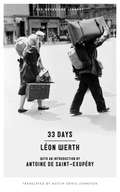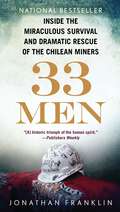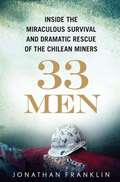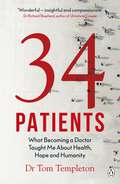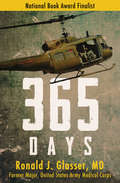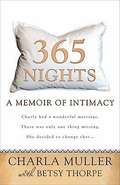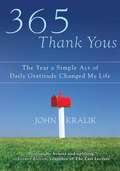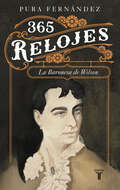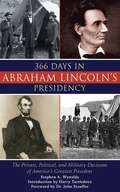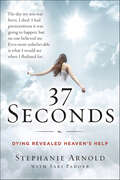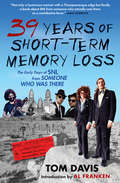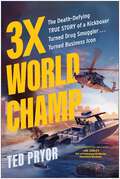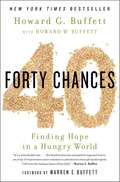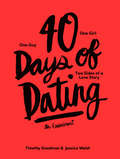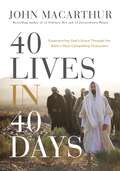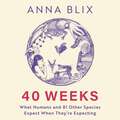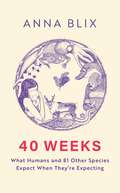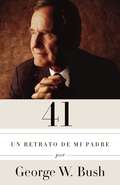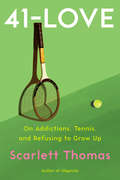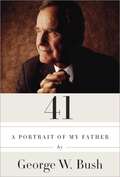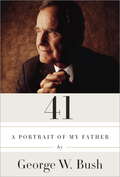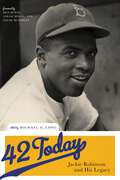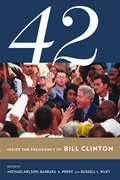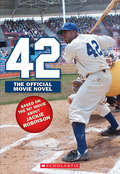- Table View
- List View
33 Days
by Austin D. Johnston Leon WerthA rare eyewitness account by an important author of fleeing the Nazis' march on Paris in 1940, featuring a never-before-published introduction by Antoine de Saint-Exupéry. In June of 1940, Leon Werth and his wife fled Paris before the advancing Nazis Army. 33 Days is his eyewitness account of that experience, one of the largest civilian dispacements in history. Encouraged to write 33 Days by his dear friend, Antoine de Saint-Exupéry, author of The Little Prince, Werth finished the manuscript while in hiding in the Jura mountains. Saint-Exupéry smuggled the manuscript out of Nazi-occupied France, wrote an introduction to the work and arranged for its publication in the United States by Brentanos. But the publication never came to pass, and Werth's manuscript would disappear for more than fifty years until the first French edition, in 1992. It has since become required reading in French schools. This, the first-ever English language translation of 33 Days, includes Saint-Exupéry's original introduction for the book, long thought to be lost. It is presented it here for the first time in any language. After more than seventy years, 33 Days appears--complete and as it was fully intended.From the Trade Paperback edition.
33 Men
by Jonathan FranklinAward-winning journalist Jonathan Franklin chronicles the harrowing account of the 33 Chilean miners who were trapped underground for fourteen weeks in the fall of 2010. Franklin, with his renowned eye for detail and dialogue, captures the remarkable story of these men to reveal to the world how they used their native talents to survive against all odds in a savage environment.
33 Men: Inside the Miraculous Survival and Dramatic Rescue of the Chilean Miners
by Jonathan Franklin<p>Having had unparalleled access to the Chilean mine disaster, award-winning journalist Jonathan Franklin takes readers to the heart of a remarkable story of human endurance, survival, and historic heroism. <p><i>33 Men</i> is the groundbreaking, authoritative account of the Chilean mine disaster, one of the longest human entrapments in history. Rushing to the scene when the miners were discovered, Franklin obtained a coveted "Rescue Team" pass and reported directly from the front lines of the rescue operation, beyond police controls, for six weeks. Based on more than 110 intimate interviews with the miners, their families, and the rescue team, Franklin's narrative captures the remarkable story of these men and women, in details shocking, beautiful, comedic, and heroic. <p>Gripping and raw with never-before-revealed details, <i>33</i> Men is a true story that reads like a thriller.</p>
34 Patients: The profound and uplifting memoir about the patients who changed one doctor’s life
by Tom TempletonDiscover the profound and moving portrait of one doctor's life and work in the NHS'Wonderful - insightful and compassionate' Dr Richard Shepherd, bestselling author of Unnatural Causes________They can't teach you how to be a doctor at medical school . . .As a junior doctor, Dr Tom Templeton learnt how to do his job from books, professors and other doctors and nurses. But the most important lessons - tolerance, kindness, resilience and bravery - he learnt from his patients.Here, he shares the stories of just 34, and how they changed his life while he was helping theirs.From a stillbirth to the old woman who lived a century, from the inhabitants of stately homes to the homeless, these stories whether heartwarming or heartbreaking, funny or tragic, are always inspiring and illuminating.We are all patients, but discover for the first time how the doctors see us . . .________'An admirably told story' Spectator'Informative and personal, humbling and healing' Observer
365 Days: 50th Anniversary Edition
by Ronald J. GlasserNational Book Award Finalist: The Vietnam War as seen through the eyes of an army doctor—&“a book of great emotional impact&” (The New York Times). In 1968, as a serviceman in the Vietnam War, Dr. Ronald Glasser was sent to Japan to work at the US Army hospital at Camp Zama. It was the only general army hospital in Japan, and though Glasser was initially charged with tending to the children of officers and government officials, he was soon caught up in the waves of casualties that poured in from every Vietnam front. Thousands of soldiers arrived each month, demanding the help of every physician within reach. In 365 Days, Glasser reveals a candid and shocking account of that harrowing experience. He gives voice to seventeen of his patients, wounded men counting down the days until they return home. Their stories bring to life a world of incredible bravery and suffering, one where &“the young are suddenly left alone to take care of the young.&” An instant classic of war literature, 365 Days is a remarkable, ground-level account of Vietnam&’s human toll.
365 Nights
by Betsy Thorpe Charla MullerWhen Charla Muller?s husband turned 40, she gave him something memorable. Sex. Every day. For an entire year. The Mullers had a solid marriage and two wonderful children, but over the years sex had fallen low on their to-do list. The lack of intimacy wasn?t causing them to drift apart, exactly, but their connection didn?t seem as great as it could be. Charla decided she couldn?t go on pretending the relationship they once had wasn?t important. The couple would embark on a year of scheduled sex, falling over Tonka trucks and piles of laundry in an effort to make time for each other. There were obstacles along the way (work implosions, faking it) and questions came to light. Will sex every day strengthen a marriage, or reveal the cracks? Pull a couple together or drive them apart? Does good sex (even mediocre sex) make up for things that aren?t so good?
365 Thank Yous: The Year a Simple Act of Daily Gratitude Changed My Life
by John KralikOne recent December, at age 53, John Kralik found his life at a terrible, frightening low: his small law firm was failing; he was struggling through a painful second divorce; he had grown distant from his two older children and was afraid he might lose contact with his young daughter; he was living in a tiny apartment where he froze in the winter and baked in the summer; he was 40 pounds overweight; his girlfriend had just broken up with him; and overall, his dearest life dreams--including hopes of upholding idealistic legal principles and of becoming a judge--seemed to have slipped beyond his reach. Then, during a desperate walk in the hills on New Year's Day, John was struck by the belief that his life might become at least tolerable if, instead of focusing on what he didn't have, he could find some way to be grateful for what he had. Inspired by a beautiful, simple note his ex-girlfriend had sent to thank him for his Christmas gift, John imagined that he might find a way to feel grateful by writing thank-you notes. To keep himself going, he set himself a goal--come what may--of writing 365 thank-you notes in the coming year.One by one, day after day, he began to handwrite thank yous--for gifts or kindnesses he'd received from loved ones and coworkers, from past business associates and current foes, from college friends and doctors and store clerks and handymen and neighbors, and anyone, really, absolutely anyone, who'd done him a good turn, however large or small. Immediately after he'd sent his very first notes, significant and surprising benefits began to come John's way--from financial gain to true friendship, from weight loss to inner peace. While John wrote his notes, the economy collapsed, the bank across the street from his office failed, but thank-you note by thank-you note, John's whole life turned around. 365 Thank Yous is a rare memoir: its touching, immediately accessible message--and benefits--come to readers from the plainspoken storytelling of an ordinary man. Kralik sets a believable, doable example of how to live a miraculously good life. To read 365 Thank Yous is to be changed.
365 relojes: Vida de la Baronesa de Wilson (1833-1923)
by Pura FernándezLa primera biografía de la autodenominada baronesa de Wilson basada en lo que realmente fue y no en lo que dijo ser. ¿Cómo se puede perder el rastro histórico de una mujer que se codeó con Lamartine o Gertrudis Gómez de Avellaneda, que fue la agente literaria de Alejandro Dumas para los países de habla hispana, que frecuentó la corte de Isabel II, que fue protegida del presidente mexicano Porfirio Díaz y que vio cómo se publicaron en vida dos biografías sobre sus andanzas? Pura Fernández ha sabido manejarse con destreza en el laberinto de documentos, hechos, dudas y contradicciones que rodean a Emilia Serrano García, autodenominada Baronesa de Wilson, y nos revela, con gran pulso narrativo, su verdadero rostro. A través de su vida reconstruye también el relato de las mujeres emprendedoras que, relegadas a un segundo plano de la historia, reformularon todos los estereotipos tradicionales de lasociedad decimonónica. Esta trama novelesca no solo revela cómo se puede pasar de ser una exitosa empresaria cultural en el París de Eugenia de Montijo y de Napoleón III, una viajera aclamada en todas las repúblicas americanas y la impulsora de las relaciones transatlánticas entre España y sus antiguas colonias, a morir arruinada y olvidada, pero no vencida; muestra también, sobre todo, cómo es posible alcanzar desde una posición problemática (como mujer no normativa) el éxito y la autoridad cultural a través de un sabio manejo de las redes sociales del momento y de un concepto muy moderno de la celebridad contemporánea.
366 Days in Abraham Lincoln's Presidency: The Private, Political, and Military Decisions of America's Greatest President
by Harry Turtledove Stephen A. WynaldaIn a startlingly innovative format, journalist Stephen A. Wynalda has constructed a painstakingly detailed day-by-day breakdown of president Abraham Lincoln's decisions in office-including his signing of the Homestead Act on May 20, 1862; his signing of the legislation enacting the first federal income tax on August 5, 1861; and more personal incidents like the day his eleven-year-old son, Willie, died. Revealed are Lincoln's private frustrations on September 28, 1862, as he wrote to vice president Hannibal Hamlin, "The North responds to the [Emancipation] proclamation sufficiently with breath; but breath alone kills no rebels." 366 Days in Abraham Lincoln's Presidency includes fascinating facts like how Lincoln hated to hunt but loved to fire guns near the unfinished Washington monument, how he was the only president to own a patent, and how he recited Scottish poetry to relieve stress. As Scottish historian Hugh Blair said, "It is from private life, from familiar, domestic, and seemingly trivial occurrences, that we most often receive light into the real character." Covering 366 nonconsecutive days (including a leap day) of Lincoln's presidency, this is a rich, exciting new perspective of our most famous president. This is a must-have edition for any historian, military history or civil war buff, or reader of biographies.
37 Seconds: Dying Revealed Heaven's Help
by Stephanie Arnold Sari Padorr“Riveting . . . inspiring. . . . the story of what happened to this woman when she died for 37 seconds will make you rethink how we all should live.” —Maureen Maher, CBS News correspondent, 48 HoursWhen she was pregnant with her second child, Stephanie Arnold had a sudden and overwhelming premonition that she would die during the delivery. Though she tried to tell the medical team and her family what was going to happen, neither the doctors nor her loved ones gave her warnings credence. Finding no physical indications that anything was wrong, they attributed her foreboding to hormones and anxiety.One member of the medical team did take her concerns seriously enough, and made the fateful decision to order extra units of blood “just in case.” Then, during the delivery, Stephanie suffered a rare Amniotic Fluid Embolism. She went into cardiac arrest and flat-lined for 37 seconds. She died. Using the supplementary blood, the medical team revived her, and she remained unconscious for more than six days.After months of recovery, Stephanie began to remember details of her experience, details she knew because she had witnessed the entire dramatic event, including her death, from outside her body—beside other spirits that were with her. In this remarkable true story, Stephanie recounts her harrowing journey and shares her surprising spiritual discoveries: we are not alone and have more loving help than we can imagine surrounding us.“Stephanie Arnold’s journalistic instincts made this remarkable happening a compelling reading experience.” —Dennis Swanson, President of Station Operations at Fox Television“Arnold’s amazing, enthralling, and revealing story . . . could redefine the way clergy, physicians, and scientists think about dying.” —Dr. Rachael Ross, co-host of The Doctors
39 Years of Short-Term Memory Loss: The Early Days of SNL from Someone Who Was There
by Al Franken Tom DavisThirty-Nine Years of Short-term Memory Loss is a seriously funny and irreverent memoir that gives an insider’s view of the birth and rise of Saturday Night Live, and features laugh-out-loud stories about some of its greatest personalities-Al Franken, Lorne Michaels, Dan Aykroyd, John Belushi, Bill Murray, Michael O’Donoghue, and Chris Farley. Tom Davis’s voice is rich with irony and understatement as he tells tales of discovery, triumph, and loss with relentless humor. His memoir describes not only his experiences on the set of SNL but also his suburban childhood, his high school escapades in the '60s, his discovery of sex, and how he reveled in the hippie culture-and psychoactive drugs-from San Francisco to Kathmandu to Burning Man over the last four decades. Hysterical, lucid, and wise, Thirty-Nine Years of Short-term Memory Loss is an unforgettable romp in an era of sex, drugs, and comedy.
3X World Champ: The Death-Defying True Story of a Kickboxer Turned Drug Smuggler . . . Turned Business Icon
by Ted PryorThe thrilling true story of the rise and fall of a kickboxing legend in the notorious 1980s Miami crime scene . . . and the shocking end that that led him to a new life. From 1982 to 1987, Thaddeus J. &“Ted&” Pryor was the middleweight kickboxing champion of the world. But behind the scenes, he was a key player in the biggest marijuana trafficking operation in American history. As a renowned athlete, TV model, and bodyguard to stars like Elvis Presley, he drew the attention of the head of the Miami mafia. When the kingpin wanted protection—and some flash—he made Ted his personal intimidator, keeping the peace in the celebrity-drenched nightclub scene and beyond. But when the gangster blocked him from getting in on the big money of the smuggling business, Ted started his own. Three-Time World Champ tells the electric story of how Ted became the master of the run-and-gun smuggling business around the Caribbean islands, hustling in hundreds of millions of dollars in weed under the noses of cops and coast guard patrols—until a dubious traffic stop began the unraveling of everything. What began as easy money became a ringside seat to kidnapping, murder, police double-crosses, and a harrowing turn in prison. Three-Time World Champ brings readers directly into the action of neon-soaked, 1980s Miami, chronicling the rise and fall—and rise again—of an amazing man: a world champ of kickboxing and a world champ of smuggling who, in a wholly unexpected turn, becomes world champ of a business completely removed from everything that came before. It&’s harrowing, it&’s thrilling, and it happened just like this: the wild life of a Three-Time World Champ.
40 Chances
by Howard G BuffettIf you had the resources to accomplish something great in the world, what would you do?Legendary investor Warren Buffett posed this challenge to his son in 2006, when he announced he was leaving the bulk of his fortune to philanthropy. Howard G. Buffett set out to help the most vulnerable people on earth--nearly a billion individuals who lack basic food security. And Howard has given himself a deadline: 40 years to put more than $3 billion to work on this challenge. Each of us has about 40 chances to accomplish our goals in life. This is a lesson Howard learned through his passion for farming. All farmers can expect to have about 40 growing seasons, giving them just 40 chances to improve on every harvest. This applies to all of us, however, because we all have about 40 productive years to do the best job we can, whatever our passions may be. 40 Chances: Finding Hope in a Hungry World is a new book that captures Howard's journey. Beginning with his love for farming, we join him around the world as he seeks out new approaches to ease the suffering of so many. It is told in a unique format: 40 stories that will provide readers a compelling look at Howard's lessons learned, ranging from his own backyard to some of the most difficult and dangerous places on Earth.
40 Days of Dating: An Experiment
by Jessica Walsh Timothy Goodman&“What would happen if Harry met Sally in the age of Tinder and Snapchat? . . . A field guide to Millennial dating in New York City&” (New York Daily News). When New York–based graphic designers and long-time friends Timothy Goodman and Jessica Walsh found themselves single at the same time, they decided to try an experiment. The old adage says that it takes forty days to change a habit—could the same be said for love? So they agreed to date each other for forty days, record their experiences in questionnaires, photographs, videos, texts, and artworks, and post the material on a website they would create for this purpose. What began as a small experiment between two friends became an Internet sensation, drawing five million unique (and obsessed) visitors from around the globe to their site and their story. 40 Days of Dating: An Experiment is a beautifully designed, expanded look at the experiment and the results, including a great deal of material that never made it onto the site, such as who they were as friends and individuals before the forty days and who they have become since.
40 Lives in 40 Days: Experiencing God’s Grace Through the Bible’s Most Compelling Characters
by John F. MacArthurHave you ever wondered why God uses ordinary people to accomplish His work and to spread the good news? Join bestselling author and Bible teacher John MacArthur as he takes a closer look at the everyday lives of the men and women that God trusted to carry His message and lead His people. 40 Lives in 40 Days is a brand-new devotional compilation of MacArthur's extensive studies of the Bible characters who show us that we don't have to be perfect to do God's work. From the twelve disciples to the Samaritan woman, MacArthur shares that Jesus chose average people--fishermen, tax collectors, doubters, political zealots--and gave them a remarkable mission.These encouraging stories, based in Scripture, help shed light on these real men and women who endured struggle, pain, and heartache, just like us. They were perfectly ordinary sinners--living proof of God's kindness--who went on to serve an extraordinary purpose in spreading the gospel.By tracing the lives of these unlikely heroes, MacArthur shows us that the difficulties and temptations that they lived through are the same trials that modern believers face today.Throughout 40 Lives in 40 Days, MacArthur will:Dive deep into the stories of Jesus' earliest disciplesTeach us that God continues to mold and use ordinary people todayShare the surprising ways God accomplishes His purposesProvide an honest look at all of God's peopleHelp you experience God's goodness and graceAs you get to know each of these 40 figures even better, you'll see why the lives they led can still serve as an inspiration to believers today.
40 Weeks: What Humans and 81 Other Species Expect When They're Expecting
by Anna BlixMatrescene meets the Golden Mole - discover what the animal kingdom expects when it's expectingIt takes 40 weeks to grow a human baby. And the relationship between a foetus and a pregnant woman is a little like that of a parasite and its host. One takes and takes, while the other continues to give, risking their health in the process.Is there a better way?The Komodo dragon can reproduce via pathogenesis - fertilising its own eggs, so no male is needed.The Surinam toad harbours live babies in craters under its skin - until they're ready to burst out into the world. And the hyena . . . Well, best not mention the hyena . . .Anna Blix takes the reader on a fascinating journey through her own pregnancy, introducing us in each of the 40 weeks to other creatures who have just delivered their next generation into the world. This fun, informative and personable book provides evolutionary comfort throughout the long haul of pregnancy, and an explanation as to how we ended up here: as the smartest species with a tiresome, but perhaps not so bad way to reproduce. It could always be worse. Just ask the hyena.Translated from the Norwegian by Nicola Smalley
40 Weeks: What Humans and 81 Other Species Expect When They're Expecting
by Anna BlixMatrescene meets the Golden Mole - discover what the animal kingdom expects when it's expectingIt takes 40 weeks to grow a human baby. And the relationship between a foetus and a pregnant woman is a little like that of a parasite and its host. One takes and takes, while the other continues to give, risking their health in the process.Is there a better way?The Komodo dragon can reproduce via pathogenesis - fertilising its own eggs, so no male is needed.The Surinam toad harbours live babies in craters under its skin - until they're ready to burst out into the world.And the hyena . . . Well, best not mention the hyena . . .Anna Blix takes the reader on a fascinating journey through her own pregnancy, introducing us in each of the 40 weeks to other creatures who have just delivered their next generation into the world. This fun, informative and personable book provides evolutionary comfort throughout the long haul of pregnancy, and an explanation as to how we ended up here: as the smartest species with a tiresome, but perhaps not so bad way to reproduce. It could always be worse. Just ask the hyena.Translated from the Norwegian by Nicola Smalley
41
by George W. Bush Claudia CasanovaNunca desde los tiempos de John Quincy Adams y John Adams en la Casa Blanca hace 190 años han sido padre e hijo presidentes de los Estados Unidos. En 41: un retrato de mi padre, George W. Bush el presidente número 43, nos guía a lo largo de la vida y el liderazgo de su padre, George H.W. Bush, el presidente número 41. Íntimo y conmovedor, 41 es un libro que solo un hijo --y también presidente-- podía escribir. La vida de George H.W. Bush es una gran historia americana. A raíz del ataque a Pearl Harbor y contra los deseos de su padre, pospuso sus estudios para pilotar en las fuerzas armadas durante la Segunda Guerra Mundial. Tras varias misiones en el Pacífico, regreso a Estados Unidos donde se casó con Barbara Pierce, la mujer que tanta influencia tendría sobre padre e hijo. Tras una exitosa carrera en Wall Street, su espíritu aventurero hizo que la joven familia se trasladara a Texas. Recordando su niñez en Midland, Texas, George W. Bush explora como su padre desarrolló su instinto, su capacidad para las relaciones personales, y su habilidad para arriesgar al tiempo que triunfaba en el mundo del petróleo primero y en política después. George W. Bush describe las extraordinarias tres décadas de su padre en la política --en el Congreso primero, más tarde como embajador, director de la CIA, vicepresidente bajo Ronald Reagan y finalmente presidente de los Estados Unidos en 1988. Pero más que una biografía, 41 nos ofrece las lecciones que un hijo aprendió del hombre al que admira y adora. George W. Bush reflexiona sobre la influencia que su padre tuvo en su vida tanto personal como política, y revela como el apoyo constante y silencioso de su padre lo ayudó en los momentos más difíciles. George H.W. Bush fue uno de los políticos más influyentes norteamericano del siglo XX, y uno de los hombres de estado más queridos del siglo XXI. 41 es un emotivo tributo a un inspirador padre y a un gran estadounidense.
41
by George W. BushNunca desde los tiempos de John Quincy Adams y John Adams en la Casa Blanca hace 190 años han sido padre e hijo presidentes de los Estados Unidos. En 41: un retrato de mi padre, George W. Bush el presidente número 43, nos guía a lo largo de la vida y el liderazgo de su padre, George H.W. Bush, el presidente número 41. Íntimo y conmovedor, 41 es un libro que solo un hijo y también presidente podía escribir. La vida de George H.W. Bush es una gran historia americana. A raíz del ataque a Pearl Harbor y contra los deseos de su padre, pospuso sus estudios para pilotar en las fuerzas armadas durante la Segunda Guerra Mundial. Tras varias misiones en el Pacífico, regreso a Estados Unidos donde se casó con Barbara Pierce, la mujer que tanta influencia tendría sobre padre e hijo. Tras una exitosa carrera en Wall Street, su espíritu aventurero hizo que la joven familia se trasladara a Texas. Recordando su niñez en Midland, Texas, George W. Bush explora como su padre desarrolló su instinto, su capacidad para las relaciones personales, y su habilidad para arriesgar al tiempo que triunfaba en el mundo del petróleo primero y en política después. George W. Bush describe las extraordinarias tres décadas de su padre en la política en el Congreso primero, más tarde como embajador, director de la CIA, vicepresidente bajo Ronald Reagan y finalmente presidente de los Estados Unidos en 1988. Pero más que una biografía, 41 nos ofrece las lecciones que un hijo aprendió del hombre al que admira y adora. George W. Bush reflexiona sobre la influencia que su padre tuvo en su vida tanto personal como política, y revela como el apoyo constante y silencioso de su padre lo ayudó en los momentos más difíciles. George H.W. Bush fue uno de los políticos más influyentes norteamericano del siglo XX, y uno de los hombres de estado más queridos del siglo XXI. 41 es un emotivo tributo a un inspirador padre y a un gran estadounidense.
41-Love: A Memoir
by Scarlett ThomasA darkly funny sports memoir about a mid-life crisis, exercise addiction, tennis, and how to grow up when you really, really don't want toAt forty-one, Scarlett Thomas was a successful novelist and a senior academic. She&’d quit smoking, gotten healthier, settled down in a lovely house with a wonderful partner. She&’d had all the therapy. Then her beloved dog died. Her parents started to get sick right around the time she realized she was never going to be a mother herself. For the first time in her life, maintaining her ideal weight had become nearly impossible. She was supposed to grow up, but she didn&’t know how. So instead she decided to regress, to go back to the thing she&’d loved best as a child but had inexplicably abandoned: tennis. Thomas knows she&’s not the only person to have wondered whether throwing enough money and time and passion at something can make your dream come true. 41–Love is heartbreaking but frequently funny as Thomas finds she&’ll do anything to win—almost anything.
41: A Portrait of My Father
by George W. BushGeorge W. Bush, the 43rd President of the United States, has authored a personal biography of his father, George H. W. Bush, the 41st President. <P> Forty-three men have served as President of the United States. Countless books have been written about them. But never before has a President told the story of his father, another President, through his own eyes and in his own words. A unique and intimate biography, the book covers the entire scope of the elder President Bush’s life and career, including his service in the Pacific during World War II, his pioneering work in the Texas oil business, and his political rise as a Congressman, U.S. Representative to China and the United Nations, CIA Director, Vice President, and President. The book shines new light on both the accomplished statesman and the warm, decent man known best by his family. In addition, George W. Bush discusses his father’s influence on him throughout his own life, from his childhood in West Texas to his early campaign trips with his father, and from his decision to go into politics to his own two-term Presidency.
41: A Portrait of My Father (A\vintage Español Original Ser.)
by George W. BushGeorge W. Bush, the 43rd President of the United States, has authored a personal biography of his father, George H. W. Bush, the 41st President. Forty-three men have served as President of the United States. Countless books have been written about them. But never before has a President told the story of his father, another President, through his own eyes and in his own words. A unique and intimate biography, the book covers the entire scope of the elder President Bush's life and career, including his service in the Pacific during World War II, his pioneering work in the Texas oil business, and his political rise as a Congressman, U.S. Representative to China and the United Nations, CIA Director, Vice President, and President. The book shines new light on both the accomplished statesman and the warm, decent man known best by his family. In addition, George W. Bush discusses his father's influence on him throughout his own life, from his childhood in West Texas to his early campaign trips with his father, and from his decision to go into politics to his own two-term Presidency.
42 Today: Jackie Robinson and His Legacy (Washington Mews Books)
by Ken Burns Sarah Burns David McMahon MichaeL G Long&“Essays on the baseball great&’s impact on American society . . . A successful attempt to give a towering cultural figure his due beyond the baselines.&” —Kirkus Reviews (starred review) Before the United States Supreme Court ruled against segregation in public schools, and before Rosa Parks refused to surrender her bus seat in Montgomery, Alabama, Jackie Robinson walked onto the diamond on April 15, 1947, as first baseman for the Brooklyn Dodgers, making history as the first African American to integrate Major League Baseball in the twentieth century. Today a national icon, Robinson was a complicated man who navigated an even more complicated world that both celebrated and despised him. Many are familiar with Robinson as a baseball hero. Few, however, know of the inner turmoil that came with his historic status. Featuring piercing essays from a range of distinguished sportswriters, cultural critics, and scholars, this book explores Robinson&’s perspectives and legacies on civil rights, sports, faith, youth, and nonviolence, while providing rare glimpses into the struggles and strength of one of the nation&’s most athletically gifted and politically significant citizens. Featuring a foreword by celebrated directors and producers Ken Burns, Sarah Burns, and David McMahon, this volume recasts Jackie Robinson&’s legacy and establishes how he set a precedent for future civil rights activism, from Black Lives Matter to Colin Kaepernick. &“This collection of essays explores baseball legend Jackie Robinson&’s complicated legacy, his impact on society and the inner turmoil that came with his historic achievements.&” —USA Today &“Even those who know nothing about Robinson will take something inspiring away from this excellent anthology.&” —Publishers Weekly
42: Inside the Presidency of Bill Clinton (Miller Center of Public Affairs Books)
by Michael Nelson Barbara A. Perry Russell L. RileyThis book uses hundreds of hours of newly opened interviews and other sources to illuminate the life and times of the nation's forty-second president, Bill Clinton. Combining the authoritative perspective of these inside accounts with the analytic powers of some of America's most distinguished presidential scholars, the essays assembled here offer a major advance in our collective understanding of the Clinton White House. Included are path-breaking chapters on the major domestic and foreign policy initiatives of the Clinton years, as well as objective discussions of political success and failure. p>42 is the first book to make extensive use of previously closed interviews collected for the Clinton Presidential History Project, conducted by the Presidential Oral History Program of the University of Virginia's Miller Center. These interviews, recorded by teams of scholars working under a veil of strict confidentiality, explored officials' memories of their service with President Clinton and their careers prior to joining the administration. Interviewees also offered political and leadership lessons they had gleaned as eyewitnesses to and shapers of history. Their spoken recollections provide invaluable detail about the inner history of the presidency in an age when personal diaries and discursive letters are seldom written. The authors producing this volume had first access to more than fifty of these cleared interviews, including sessions with White House chiefs of staff Mack McLarty and Leon Panetta, Secretaries of State Warren Christopher and Madeleine Albright, National Security Advisors Anthony Lake and Sandy Berger, and a host of political advisors who guided Clinton into the White House and helped keep him there. This book thus provides a multidimensional portrait of Bill Clinton's administration, drawing largely on the observations of those who knew it best.p>ContributorsSpencer D. Bakich, University of RichmondBrendan J. Doherty, United States Naval AcademyPatrick T. Hickey, West Virginia Universityp>Elaine Kamarck, Center for Effective Public Management, Brookings InstitutionSidney M. Milkis, University of VirginiaMegan Moeller, University of Texas at AustinMichael Nelson, Rhodes College and the Miller Center, University of Virginia>Bruce F. Nesmith, Coe CollegeBarbara A. Perry, Miller Center, University of VirginiaPaul J. Quirk, University of British Columbiap>Russell L. Riley, Miller Center, University of Virginia Andrew Rudalevige, Bowdoin CollegeRobert A. Strong, Washington and Lee UniversitySean M. Theriault, University of Texas at Austin
42: The Jackie Robinson Story
by Aaron RosenbergA movie tie-in novel about Jackie Robinson's life story. In theaters 4/12/13. A novel based on the movie 42--a biopic about Jackie Robinson's history-making signing with the Brooklyn Dodgers as the first African American Major League Baseball player. Includes a full-color insert of photos from the movie.
